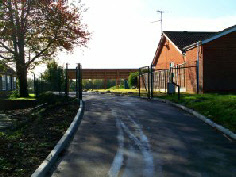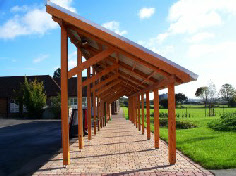

Make a point of visiting us weekly!
Centre for Disability Studies
Disability Essex
Disability Essex


The hi-tech plant room with MVHR units and hot water tanks


Introduction
In the last week of November 2010, we visited the ‘Disability Centre’ in Rocheway and were given a run-down of the building by Stuart Kirk, the Project Manager for the Centre. Descriptions don’t do justice to the building. When you go in to the centre (by foot through the side gate near the solar panels, or by vehicle, needing to buzz for attention at the front gate) you are immediately struck by the lightness of the building which, we realised on a cloudy day) needed no lights on. Obviously, as its name implies, it is designed for disability users and all doors respond to a large press-pad. Everything about it is designed for disability users but its hi-tec feel suggests it is something much more. Let Stuart continue to tell us about it. As you’ll see there are difficulties over its usage because of the sensitivity of its location.
2. The Building
RL: Stuart, now tell me about this building.
Stuart: We used to have a three storey town house in the middle of Chelmsford. It used to cost us about five or six thousand pounds a year to heat. It was 1920’s, the roof was leaking, the electrics were in a bad state and it was going to cost about a third of a million to upgrade. Our Chief Executive attended a meeting where there was a guest speaker who was talking about the new way forward, the low energy future, and it struck a chord with him and he pursued it and it’s taken about six years for this building to come to fruition.
This is one of the most energy efficient buildings of its type in the country. We have been awarded what is known as the Passivhaus Standard (German - for further details & example see http://www.100khouse.com/2008/04/10/passive-house-passivhaus-standard-for-energy-efficient-design/ ).
There are only three non-domestic properties in the UK who have that standard. This is one of them. One of them is a training centre in North Wales, and one is an office in Kent. The idea is that a building should have minimum impact on the environment. This area is 500 square metres and one of the requirements for Passivhaus is that it uses not more than 15Kw to heat and cool it per square metre per year. So if you take 500 sq.m @ 15Kw that is 7,500 and what is the price of one unit of electricity? If you pay 5p a unit that is £375 heating bill per year. If you pay 10p a unit that is £750 per year.
RL: Can I ask a key question: how much more did it cost to build this building to these requirements than if it had been an ordinary building?
Stuart: Approximately one third. We paid the builder £1.3M.
For the total cost, we then add on the price of the land which we bought from the County Council, plus the Architect’s fees, plus the aborted Architects and Planning Costs. We had difficulties along the way – we had been offered a total of fourteen sites, all of which either failed to get planning permission or there was some other glitch.
For example we were looking at one site and we had the plans drawn up and we discovered only at the last minute that the land was only available on leasehold. The Charity Commission said you can’t do that because that would be tantamount to giving away the charity’s assets; you have to have it freehold not leasehold.
We went into another site, modified the plans, all was going swimmingly and just before we signed the contracts, problems cropped up on the vendor’s side and it was no longer sold to us.
So we’ve hit all sorts of problems and a lot of frustrated costs before we actually came here. Then you have to add the cost of kitting the building out, so the bottom line is a total of about two and a quarter million pounds.
A lot of it came from the East of England Development Agency and various other sources plus the leftover from the sale of our house in Chelmsford, plus various donations from charitable organisations.
RL: A further crucial question: here we are sitting in this largely empty building here on a Monday morning in November. I assume you are gradually building up its usage?
Stuart: No. We are sitting in the South Wing. The original plan was for the South Wing to be half this size but then the East of England Development Agency said, if you built the South Wing bigger than you need you could rent it out and then what you get from rental would help cover the Charity’s operating costs and we’ll give you the extra money.
However there was a small problem. The fence behind us is the edge of the Green Belt so we are actually on Green Belt. The Council was understandably reluctant to give us planning permission and so they imposed a restriction that only Disability Essex can occupy the building. The building was built to give us the revenue from renting out this South Wing but now we are unable to do that and we cannot rent it out. The permission allowed only group D1, charities, health-care and so on. During the Summer we applied to have a Disabled Children’s Day-care Centre here, operating out of this room, and that was refused it on the grounds of inappropriate usage, so we are now struggling to find somebody who would be an acceptable tenant.
2B. More on its Usage
In the North Wing there are five offices where we’ve got our various staff – three full time and a number of part-timers and volunteers. For example we have a telephone help-line for any disability related issues, from how do a get a new blue badge, to do you know of a visiting chiropodist or visiting hairdresser?
They have this big database of information, not merely in Essex, but we’ve been going sixty years and we have a grant from Capacity Builders (see http://www.capacitybuilders.org.uk/ but soon to be abolished), a three year package to expand our working practice across the whole east of England, and so working with other partners across the east of England we have set up a regional database so that if you have an aged relative in Norfolk, Suffolk, etc. in the east, you could phone us and ask, say, how can I get blue badge in Norfolk, or if you have children who are concerned about your well-being who live out of country, they could phone their centre and interrogate our database to get information about Essex. I think there have been about four and a half thousand entries for this regional data base. Because Essex is going to come out of the East of England, and into the South-East Economic Partnership, we’re having to talk to Kent and Sussex about involving them in this database now. You have all this data and you can’t just let it go to waste, so we have teams of volunteers who are constantly looking for new information, checking the validity of the old information and so on.
Another project we are working with is mobility scooter training. It’s a variety of ongoing projects.
Another thing we are doing is working with a local university on a research project. Children worry about their aged parents living on their own, so we’re putting together this little package which will quietly sit in the house of the aged parent and do nothing, until they do nothing. It monitors activities, very discretely and builds up a picture of what they normally do so, for example, if they always get up to the toilet every night about 2-3 o’clock in the morning, and get up at 7 o’clock in the morning, make a cup of tea, it creates this picture of your normal daily activity – this is still in the research stage, they are now building a prototype – so if they don’t go to the loo and they always go to the loo, the system asks what is going on. If they don’t make a cup of tea in the morning or doesn’t switch the light on, several things can happen. It sets off a buzzer on the bedside table or wherever, and they hit a button, they have responded. But if they don’t it telephones a pre-designated number and issues a warning, so that you or a neighbour or a warden can go round and check. The old emergency button required you to do something active but if you are not in the position to do it, this tells someone. We want to market it so a basic package would come in at about a hundred pounds. It needs to be a fairly simple installation at the home handyman level of installation.
We have a lot of things in the pipeline but of course, possibly all won’t come to fruition.
To return to 1. The Charity CLICK HERE To proceed to 3. The Man CLICK HERE
In the last week of November 2010, we visited the ‘Disability Centre’ in Rocheway and were given a run-
2. The Building
RL: Stuart, now tell me about this building.
Stuart: We used to have a three storey town house in the middle of Chelmsford. It used to cost us about five or six thousand pounds a year to heat. It was 1920’s, the roof was leaking, the electrics were in a bad state and it was going to cost about a third of a million to upgrade. Our Chief Executive attended a meeting where there was a guest speaker who was talking about the new way forward, the low energy future, and it struck a chord with him and he pursued it and it’s taken about six years for this building to come to fruition.
This is one of the most energy efficient buildings of its type in the country. We have been awarded what is known as the Passivhaus Standard (German -
There are only three non-
RL: Can I ask a key question: how much more did it cost to build this building to these requirements than if it had been an ordinary building?
Stuart: Approximately one third. We paid the builder £1.3M.
For the total cost, we then add on the price of the land which we bought from the County Council, plus the Architect’s fees, plus the aborted Architects and Planning Costs. We had difficulties along the way – we had been offered a total of fourteen sites, all of which either failed to get planning permission or there was some other glitch.
For example we were looking at one site and we had the plans drawn up and we discovered only at the last minute that the land was only available on leasehold. The Charity Commission said you can’t do that because that would be tantamount to giving away the charity’s assets; you have to have it freehold not leasehold.
We went into another site, modified the plans, all was going swimmingly and just before we signed the contracts, problems cropped up on the vendor’s side and it was no longer sold to us.
So we’ve hit all sorts of problems and a lot of frustrated costs before we actually came here. Then you have to add the cost of kitting the building out, so the bottom line is a total of about two and a quarter million pounds.
A lot of it came from the East of England Development Agency and various other sources plus the leftover from the sale of our house in Chelmsford, plus various donations from charitable organisations.
RL: A further crucial question: here we are sitting in this largely empty building here on a Monday morning in November. I assume you are gradually building up its usage?
Stuart: No. We are sitting in the South Wing. The original plan was for the South Wing to be half this size but then the East of England Development Agency said, if you built the South Wing bigger than you need you could rent it out and then what you get from rental would help cover the Charity’s operating costs and we’ll give you the extra money.
However there was a small problem. The fence behind us is the edge of the Green Belt so we are actually on Green Belt. The Council was understandably reluctant to give us planning permission and so they imposed a restriction that only Disability Essex can occupy the building. The building was built to give us the revenue from renting out this South Wing but now we are unable to do that and we cannot rent it out. The permission allowed only group D1, charities, health-
2B. More on its Usage
In the North Wing there are five offices where we’ve got our various staff – three full time and a number of part-
They have this big database of information, not merely in Essex, but we’ve been going sixty years and we have a grant from Capacity Builders (see http://www.capacitybuilders.org.uk/ but soon to be abolished), a three year package to expand our working practice across the whole east of England, and so working with other partners across the east of England we have set up a regional database so that if you have an aged relative in Norfolk, Suffolk, etc. in the east, you could phone us and ask, say, how can I get blue badge in Norfolk, or if you have children who are concerned about your well-
Another project we are working with is mobility scooter training. It’s a variety of ongoing projects.
Another thing we are doing is working with a local university on a research project. Children worry about their aged parents living on their own, so we’re putting together this little package which will quietly sit in the house of the aged parent and do nothing, until they do nothing. It monitors activities, very discretely and builds up a picture of what they normally do so, for example, if they always get up to the toilet every night about 2-
We have a lot of things in the pipeline but of course, possibly all won’t come to fruition.
To return to 1. The Charity CLICK HERE To proceed to 3. The Man CLICK HERE


No, not a bike shed but a bank
of solar panels that provides
their electricity.
of solar panels that provides
their electricity.

The South Wing

Reception & Information Desk
in Foyer
in Foyer

All WC’s are accessible & one has supplementary features

There are 3 Offices in use

The Training Room for rental
by local groups
by local groups


Pleasant outdoor areas
All photos courtesy of Disability Essex
Centre for Disability Studies
34 Rocheway,Rochford
Essex SS4 1DQ
Telephone 0844 412 1771 Facsimile 0844 880 0614
www.disabilityessex.org
34 Rocheway,Rochford
Essex SS4 1DQ
Telephone 0844 412 1771 Facsimile 0844 880 0614
www.disabilityessex.org